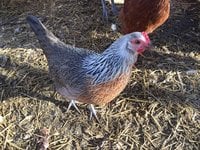Competitive breed have always had an appeal to me. The spirit and pride they have really shows through. I find this with our retired greyhounds, as I do with my American Game Bantams (AGBs). Both stand tall and at attention, ready for anything. I searched around some time for just the right breed. I tried Japanese because I prefer tall tails to horizontal tails, but they didn’t stick. I tried Buckeye bantams because I liked the idea of having an American breed, especially one developed in the state of my birth, but they didn’t stick either.
By then, I’d discovered the American Game. I was first attracted by all the Pumpkin Hulseys out there on eBay and for sale elsewhere. I loved the color, but also the proud look and the fantastic arching tails. But I wanted something smaller. That’s when I started to look at the AGBs in Storey’s Illustrated Guide to Poultry Breeds (there is one on the back cover) and started to ask around. I got my first AGBs in 2011 and, at that point, my search for a breed ended. They are gracefully curved, have a confident stance and the hens lay quite well, especially compared to the other breeds in the bantam game classes. One does have to set up more and smaller coops than you might have to with a more communal breed, but it’s been well worth it, in my opinion. American Game Bantams are a breed that is both powerful and elegant, and well worth having.
By then, I’d discovered the American Game. I was first attracted by all the Pumpkin Hulseys out there on eBay and for sale elsewhere. I loved the color, but also the proud look and the fantastic arching tails. But I wanted something smaller. That’s when I started to look at the AGBs in Storey’s Illustrated Guide to Poultry Breeds (there is one on the back cover) and started to ask around. I got my first AGBs in 2011 and, at that point, my search for a breed ended. They are gracefully curved, have a confident stance and the hens lay quite well, especially compared to the other breeds in the bantam game classes. One does have to set up more and smaller coops than you might have to with a more communal breed, but it’s been well worth it, in my opinion. American Game Bantams are a breed that is both powerful and elegant, and well worth having.

